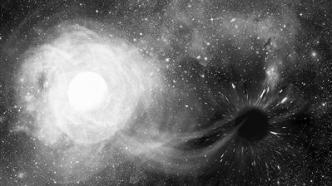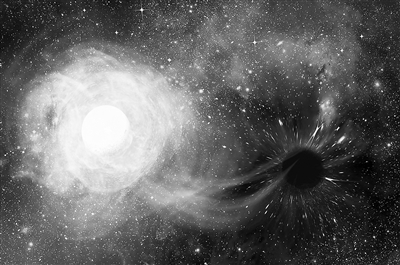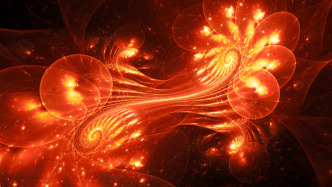

According to the new paper, the universe may not be composed of separate parts at all, but rather a single quantum object.
Being between the heaven and the earth, the question of "what is the universe" often comes to mind every time I look up and down. In fact, in the long history, people have often thought about this issue, and their understanding of this issue has also undergone a complicated evolution process.
Recently, the "New Scientist" magazine published an article entitled "Rethinking Reality: Will the Whole Universe Be a Quantum Unit", which provides us with a possible answer to the above question—the universe may be a huge and special quantum.
According to this paper, the universe may not be composed of separate parts at all, but a single quantum object. On July 24, relevant experts admitted to reporters that if evidence is found to support this idea, it may completely change the way humans think about the universe.
The human cosmology has undergone a long process of evolution
Ma Xiaohan, a doctor of the Department of Astronomy, School of Physics, University of Science and Technology of China, introduced that in ancient times, the ancient Egyptians believed that the universe was a big box with the sky as the lid and the earth as the bottom, with the Nile River in the center of the box; Tablets on several elephants, while the elephants stand on the back of a huge turtle; "the theory of round sky and earth" is the preliminary explanation of the universe by the ancient Chinese.
With the further observation and exploration of human beings, the outline of the universe has gradually become clearer. In the western scientific community, physicists' description of the universe has gone through the evolution process from "geocentric theory" to "heliocentric theory", from the solar system to the Milky Way to the entire universe. In ancient China, there were also three cosmic models: Gaitian theory, Huntian theory, and Xuanye theory.
"From the perspective of modern science, the universe is essentially a collection of time and space." Ma Xiaohan said, "In this time and space, all kinds of matter, including human beings, exist as part of the universe."
Modern science has clarified the nature of the universe, so how do we understand how the universe works? In other words, what perspective should humans use to understand the universe?
Most modern physicists tend to understand the universe from a reductionist perspective. Ma Xiaohan pointed out that from the perspective of reductionism, matter is ultimately composed of fundamental particles such as quarks. Scientists can understand the properties of the fundamental particles that make up the universe and use this to infer the nature of the universe. From this perspective, since everything in the universe is made up of indivisible material particles, as long as we find out the fundamental particles that make up the universe, and then analyze, induce, etc., we can restore the truth of the existence of the universe.
German theoretical physicist Heinrich Paz likened this process to Russian nesting dolls. "We don't need to know whether there are smaller nesting dolls in this matryoshka, but only need to pay attention to this layer of nesting dolls, and use the theory of this layer of nesting dolls to explain the physical world to a certain extent." Pass explain.
At first glance, reductionism seems to offer a simple and effective way for scientists to understand the universe. However, this approach is not perfect.
Under the guidance of reductionism, scientists established particle physics and tried to construct a model to explain all phenomena in the universe. This model is called the "Standard Model". The model summarizes 61 kinds of elementary particles, but these 61 kinds of elementary particles only account for 5% of the universe. "The remaining 95% cannot be explained by reduction theory, including about 70% of dark energy and 25% of dark matter." Ma Xiaohan pointed out. In other words, the "standard model" under the guidance of reductionism is not perfect, which prompts scientists to propose a more complete model that includes all substances and phenomena in the universe.
Gao Jie, a researcher at the Institute of High Energy Physics of the Chinese Academy of Sciences and head of the CEPC accelerator, feels the same way. He once said that so far, humans only know a small part of the universe. A large part of them—dark matter and dark energy—are still in the prediction stage of scientists and need to be verified by experimental means.
Quantum theory offers new perspective on cosmic exploration
Gao Jie believes that the study of dark matter and other issues needs to describe the particle physics of the microscopic world and the cosmoscopic world (that is, including star clusters, galaxies, galaxy clusters, super galaxy clusters, total galaxies, and material systems composed of rays and gravitational fields throughout the universe) cosmology combined. The introduction of quantum theory in cosmology provides new research ideas and theoretical frameworks for cosmology research, and can explain problems that particle physics could not explain before. Ma Xiaohan said that physicists often use rainbows as a metaphor for the correspondence between particle physics and quantum physics. In a rainbow, the seven colors of red, orange, yellow, green, cyan, blue, and purple are visible to the naked eye, while the area above purple (ie, the ultraviolet area) and the area below red (ie, the infrared area) in the rainbow are visible to the naked eye. Invisible. The visible light part is equivalent to the applicable field of the standard model of particle physics, while the "infrared and ultraviolet regions" outside the standard model of particle physics need to be explained through a new idea, that is, combining quantum mechanics and gravity.
With the deepening of research, physicists have discovered that there is an inseparable connection between the extremely large universe and the extremely small particles, and this connection can only be explained by quantum theory at present.
Scientists speculate that this phenomenon may be caused by quantum entanglement. Quantum entanglement is usually described as the correlation between quantum bodies. This correlation proves that an entangled quantum system cannot be understood as being composed of certain parts, but that they are the same whole. If the theory is true, it means that the different energy levels of the universe are actually the same, and everything in the universe is not composed of gradually smaller parts, and the entire universe is a "single, indivisible quantum body".
A sand is a world, and the world is also dust. "Actually, the scientific community has not yet formed a rigorous and unified term for the concept of 'single quantum body'." Ma Xiaohan pointed out that the current conjecture of "single quantum body" is still at the level of scientific philosophy, and scientists' exploration of the unknown part of the universe is still in progress. continue. More observational and theoretical efforts are needed to express this conjecture in a more precise way.
In the near future, if scientists can find evidence that quantum entanglement applies to the entire universe, then human beings' past view of the universe may be overturned. Humans may need to understand and recognize the universe from a new perspective—the universe as an entangled single quantum whole.
Driven by thirst for knowledge and curiosity, from looking up at the starry sky thousands of years ago to understanding the universe under the guidance of scientific observation and theory, human beings have never stopped exploring the universe. With the advancement of civilization and technology, human beings will finally unveil layers of veils and present the true face of the universe more and more clearly.
Related Links
Interesting Theories Related to the Origin of the Universe
The topic of the origin of the universe has always attracted many scientists to explore tirelessly. While scientists aren't sure exactly how the universe began, several hypotheses may shed light on the mystery.
Regarding the origin of the universe, the most popular hypothesis may be the "big bang". The hypothesis holds that the universe should have been born in a big bang 13.7 billion years ago. The universe was just an energy singularity at the beginning. This singularity does not occupy any space, but it is believed by scientists to gather all the matter and energy in the universe. At the moment when the singularity exploded, all matter and energy were released, and the material particles in the universe today were all formed within 4 minutes after the Big Bang. It was not until 380,000 years after the Big Bang that the temperature of the universe dropped to about 3,000 degrees Celsius, and the universe became transparent from the chaotic state of particle porridge. Photons began to shuttle in the universe, and atomic structures were formed.
Einstein's general theory of relativity predicted the existence of white holes. A white hole is a special celestial body whose nature is just opposite to that of a black hole. It is a jet source in the universe, which can eject matter and energy to the outer region, but cannot absorb any matter and radiation from the outer region. The matter gathered in the white hole can only move outward through the boundary, but not in the opposite direction. Some scientists believe that the white hole is connected to the black hole through a wormhole, and the matter "eaten" by the black hole is "spit out" again. Our universe may have originated from a white hole ejection.
Other scientists believe that perhaps the universe itself is a cycle. The universe continued to expand after the big bang, but when it reached a critical point where it could no longer expand, it collapsed inward until it formed a singularity again and exploded again.
(Original title "What is the universe?" Adds new conjectures and new ideas that the universe may be a huge and special quantum")


